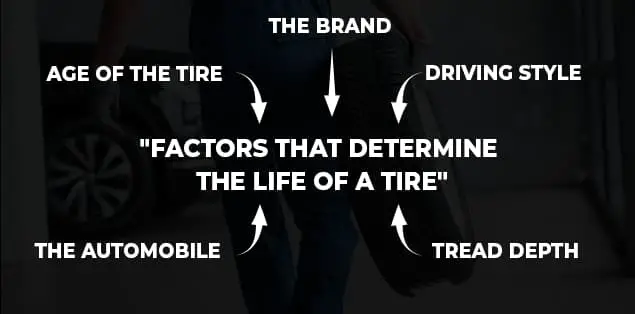So, how many miles do tires last? Tires are the only part that let the vehicles get in contact with the roads and thus can be considered limbs of the same. So, it’s essential to consider a particular product’s longevity.
We can divide tires into categories based on the vehicles. They are characterized by the type of weight they bear, including their function, like for vehicles, aircraft, or cycles. We classify this automobile item as light-medium–heavy-duty, and others.
Heavy-duty commercial vehicle tires come in various styles and can bear weights varying between 4,500 to 6,000 lbs on the driving wheel. The manufacturers often mount these in pairs on the driving axle.
Light-duty tires for automobiles bear weights ranging from 600 to 1,200 lbs on the driving wheel. Light-to-medium duty vehicles and trailers carry weights ranging from 1,200 to 3,400 lbs on the drive wheel. Light truck tires, winter tires, entry-level automobile tires, sedans and vans, performance sedans, and high-performance cars are divided into categories based on their speed rating.
Different design criteria apply to aircraft, bicycles, and many industrial applications (Others category).
This write-up will be the most helpful to those who love to travel a lot. But in general, questions like – how many miles do tires last, what kind of tread is most suitable, and the lifespan of tires need to be answered to decide what suits a particular vehicle.
This article will provide a brief overview of tires and their lifespan.
What Criteria Decides The Life of the Tire?

Multiple factors decide or influence the life of the tire. It can be the vehicle, the brand, the roadways, and much more. We have discussed some of them here to obtain clarity and comprehensibility regarding the sustenance of tires.
Age of the Tire
Tires over 6 years old, irrespective of tread depth, should be replaced. Dry rot occurs when the rubberized components in a tire wear down over time. Blowouts and tread separation are more likely in tires with dry rot.
According to vehicle and tire manufacturers, one should replace tired every 6-10 years, regardless of tread level. However, most drivers’ tire tread will wear out before their tires reach that age.
We must replace the tires with more than 10 years of tire age.
Tread Depth
Tires are the only thing that connects the car to the ground. While driving, the tread grabs the road. However, if it’s not deep enough, the automobile will lose traction and have to brake more frequently. Measure the tread depth as part of routine car maintenance to ensure safety.
We refer to the fabric on the tire that comes in touch with the road as the tread. Tread depth on fresh tires is typically 8 to 9 mm. As we drive the automobile, the tread will deplete. Tires with tread depths less than 2/32 inches have poor friction. Vehicle handling and braking distance are significantly compromised. We must replace tires like these as they are not safe for driving.
The Automobile
The vehicle on which the tires are placed, believe it or not, impacts how long they survive.
SUVs and trucks carry a lot greater weight than cars. Thus if we do not utilize the proper tires, the vehicle’s tires may wear out sooner than expected. Sometimes, there’s no clear explanation why one car’s tires last more than the other’s.
Driving Style
Someone who drives like they’re in the movie Fast and Furious is more likely to have tires that wear out way before their time. The tires will suffer damage if the car is regularly subject to strong acceleration, high loads, and aggressive driving over speed bumps and potholes.
Tire driving style and the number of miles it has traveled each year influence the tire life. Some ways in which you can improve the tires’ life are:
- To ensure and extend tire life, maintain proper tire pressure. An under-or over-inflated tire, which impacts the vehicle’s dynamics, mechanical components, and ride quality, causes uneven wear.
- Given our challenging and varied road conditions, a tire can come into unpleasant impediments such as potholes, ruts, and other road hazards. Drive cautiously across these types of terrains and avoid haphazardly dismissing them. Crushed rock can permanently damage the tire’s sidewall, necessitating a replacement.
- Driving at greater speeds daily will dramatically reduce the life of tires. A tire generates more heat since it is designed to roll quicker. As the tread advances along the road, it leaves more rubber, resulting in greater wear. Try to stay inside the speed restrictions.
- Unwarranted tire wear occurs when drivers are overly eager or accelerate off quickly from a stop. Leaving tire marks on the road may appear spectacular, but it can eventually ruin both tires and wallet.
The Brand
The normal tire on the marketplace should last roughly 65,000 miles, as per Dan Zielinski, a spokesperson for the United States Tire Manufacturers Association, but every tire is distinct.
Some tire companies provide warranties of up to 75,000 miles or more, showing that they are confident of the product’s longevity due to its manufacturing, innovation, and structure. Others, only 30,000 miles. Therefore, the product’s longevity depends on the manufacturers and the technology they are using.
The type of new tires bought impacts how long they last. According to a survey, super high-performance tires lasted approximately twice as long as family-car tires. Furthermore, the treadwear ratings and, as a result, the lifespans of all-season, summer, and winter wheels will differ.
How Many Miles Do Motorcycle Tires Last?

A motorcycle tire should last anywhere between 3,000 to 15,000 miles with average use. On the other hand, a set of sports motorcycle tires can be destroyed in less than 100 miles on a track day! A range of elements such as tire quality, tire size, riding style, bike performance, road/pavement conditions, etc., determines the tire age and the number of miles a motorcycle tire will last.
When it comes to the number of miles a motorbike tire can travel, the general rule is that the greater its performance, the fewer miles it can travel. Touring tires survive far longer than special motorcycle racing tires or other tires because of this.
Even if the motorcycle driver is not riding it aggressively, we highly suggest using top-quality, better-performance tires on the motorcycle for safety reasons.
Tires keep the motorcycle on the road, so they must heat up quickly and provide the finest grip possible. The type, weight, and performance of the motorcycle are other important elements that influence the lifespan of motorcycle tires.
As it may, the higher the performance engine on a motorcycle, the fewer miles it will cover. As a result, high-performance street motorcycles can wear down their tires more quickly than any other two-wheeler. Tires on these motorcycles usually last between 1,500 and 7,000 miles.
Tires on lighter touring bikes, on the other hand, should last 10,000-15,000 km.
You need to pay attention to ensure the tire’s longevity. The most critical measures in tire care are regular checkups, maintaining the tire’s air pressure, and ensuring wheel alignment. Because rubber ages over time, motorcycle tires typically last roughly five years. This is why, after five years, most tire manufacturers recommend replacing both tires.
We suggest periodically getting your tires checked by a professional for better tire life. Even if it hasn’t reached its limit and appears to be in good shape, a general rule is never to use a motorbike tire for more than ten years.
How Many Miles Do Car Tires Last?
Dan Zielinski mentions that some tires may be designed to last for 30,000 kilometers. Others, such as high-performance tires on vigorously driven cars, will be worn down to 2/32-inch without hitting 15,000 miles, but those are extreme situations.
Most new tires in the market today will last roughly 60,000 miles if they don’t peel off at stoplights and are maintained correctly.
It’s unknown if there are any means of knowing how many miles have been put up on a certain pair of tires, but multiplying four years by 15,000 miles yearly confirms the ballpark estimate of the tire durability and different treadwear ratings.
To know how soon the tires will wear out, we recommend calculating the number of miles you travel each year. Subtract the number of miles on the odometer from the number of years the car has been with you. Then, compare it to the promised warranty on the tire’s make and model to determine how many years of service you can expect.
For tire maintenance, regularly rotate the tires. Check the vehicle’s owner’s manual to know how often it needs its tires rotated.
How Many Miles Do Tires Generally Last?
An accurate period to realize the life of tires is not technically possible, but fortunately, there are things a driver can do to maximize their tire investment and avoid driving on dangerous tires.
People travel 12,000 to 15,000 miles per year on average, which means the average decent quality all-season tire will last three to five years, depending on maintenance, driving style, road conditions, and the climatic conditions of the area that you drive the car in.
When it comes to tire health, safer is better, so have the tires evaluated regularly if any concerns about tread wear or tire age are there.
How Often to Replace Tires?

The National Highway Traffic Safety Administration (NHTSA) suggests that drivers must change their vehicles’ tires every 6 years.
Tires will wear faster if the driver drives more aggressively, brakes more aggressively and abruptly, and accelerates very hard. The tires will wear slowly if you drive the car properly and responsibly. Furthermore, if it’s frequently driven on poorly maintained roads, the tires may experience additional wear and tear.
How Long Does It Take to Change a Tire?
The following factors determine the amount of time it takes to change a tire:
- Getting a tire changed professionally will take up to 15 mins.
- Changing a wheel takes 45 minutes to 5 hours in an auto maintenance shop.
- It takes less than an hour to change a wheel with the help of roadside assistance.
- It takes approximately 15 to 30 minutes to change a wheel independently.
- In general, you may replace a wheel in 15 minutes.
Do OEM Tires Wear Faster?
OEM tires wear out faster than aftermarket tires since most manufacturers prefer to use soft rubber for their wheels.
Although this soft rubber wears out more quickly than harder aftermarket wheels, it gives a smoother and quieter ride with excellent handling.
These characteristics boost the likelihood that people will love the car’s feel during a test drive before purchasing it.
Manufacturers recommend low tire pressures (for that, check the owner’s manual).
As a result, it’s always advisable to use the tire manufacturer’s suggested pressure (which you may find on the tire itself) rather than the automobile manufacturer’s recommended tire pressure.
Final Words – How Many Miles Do Tires Last?
In today’s era, not having a personal vehicle seems impossible because people are very busy wasting their time walking to work or using local transport. But buying a vehicle seems like less of an investment and more of a liability due to its maintenance.
Tire manufacturers offer best practices regarding tires, and you must always follow them. People need to take special care of their vehicles and every part of them, especially tires, to last longer. You must also be wondering how long can you drive on a spare tire. Don’t scratch your heads, we have you covered!
